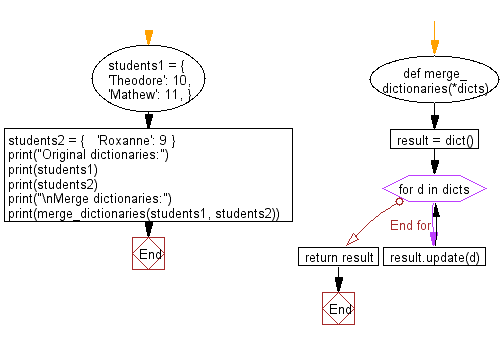Python: Merge two Python dictionaries
8. Merge Two Python Dictionaries
Write a Python script to merge two Python dictionaries.
Sample Solution-1:
Python Code:
# Create the first dictionary 'd1' with key-value pairs.
d1 = {'a': 100, 'b': 200}
# Create the second dictionary 'd2' with key-value pairs.
d2 = {'x': 300, 'y': 200}
# Create a new dictionary 'd' and initialize it as a copy of 'd1'.
d = d1.copy()
# Update the dictionary 'd' by adding key-value pairs from 'd2'.
d.update(d2)
# Print the dictionary 'd' after combining the key-value pairs from 'd1' and 'd2.
print(d)
Sample Output:
{'x': 300, 'y': 200, 'a': 100, 'b': 200}
Sample Solution-2:
Create a new dict and loop over dicts, using dictionary.update() to add the key-value pairs from each one to the result.
Python Code:
# Define a function 'merge_dictionaries' that takes a variable number of dictionaries ('*dicts') as arguments.
# It merges the dictionaries into a new dictionary and returns the result.
def merge_dictionaries(*dicts):
# Create an empty dictionary 'result' to store the merged key-value pairs.
result = dict()
# Iterate through the input dictionaries ('dicts') using a for loop.
for d in dicts:
# Update the 'result' dictionary by adding key-value pairs from the current dictionary 'd'.
result.update(d)
# Return the merged 'result' dictionary.
return result
# Create two dictionaries 'students1' and 'students2' with key-value pairs.
students1 = {
'Theodore': 10,
'Mathew': 11,
}
students2 = {
'Roxanne': 9
}
# Print a message indicating the start of the code section.
print("Original dictionaries:")
# Print the original dictionaries 'students1' and 'students2'.
print(students1)
print(students2)
# Print a message indicating the start of the merged dictionaries section.
print("\nMerge dictionaries:")
# Call the 'merge_dictionaries' function with 'students1' and 'students2' as arguments to merge the dictionaries.
# Print the result, which is the merged dictionary.
print(merge_dictionaries(students1, students2))
Sample Output:
Original dictionaries:
{'Theodore': 10, 'Mathew': 11}
{'Roxanne': 9}
Merge dictionaries:
{'Theodore': 10, 'Mathew': 11, 'Roxanne': 9}
Flowchart:

For more Practice: Solve these Related Problems:
- Write a Python script to merge two dictionaries and handle overlapping keys by taking the value from the second dictionary.
- Write a Python script to merge two dictionaries using the unpacking operator (**) and print the result.
- Write a Python script to merge two dictionaries recursively when keys map to sub-dictionaries.
- Write a Python script to combine dictionaries and, in case of key collisions, concatenate their values if they are strings.
Go to:
Have another way to solve this solution? Contribute your code (and comments) through Disqus.
Previous: Write a Python script to print a dictionary where the keys are numbers between 1 and 15 (both included) and the values are square of keys.
Next: Write a Python program to iterate over dictionaries using for loops.
Python Code Editor:
What is the difficulty level of this exercise?
Test your Programming skills with w3resource's quiz.
